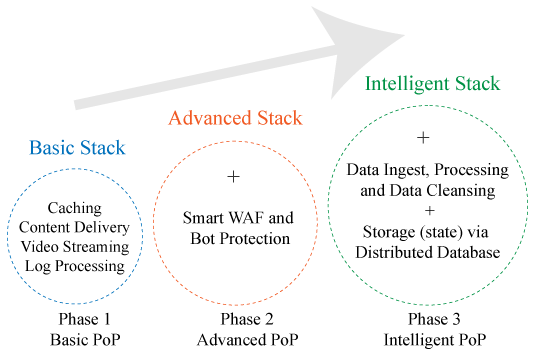Over the last seven years, the technology stack (“stack”) in the CDN PoP has matured. The evolution of the stack can be broken down into three phases: basic, advanced, and intelligent. The basic stack involves caching and content delivery, video streaming, and processing of log files. This stack graduated to phase 2 with the arrival of the smart WAF and smart bot mitigation product. The smart products incorporate advanced functionality to analyze HTTP request in real-time, in order to determine if it is a threat or not, using features like device fingerprinting and machine learning.
The drivers in the first two phases – deliver content quickly and secure it. The driver for phase 3 is the edge, a period that will see the introduction of a host of new applications, many yet to be developed, that will harness the power of IoT, 5G, edge AI, VR, self-driving cars, smart appliances, Next-Gen GPON (broadband), etc. Edge Gravity (Ericsson) markets its edge product as a localized solution that is embedded deep inside the telco last-mile network.
In phase 3, the PoP becomes an intelligent ecosystem that is self-contained and localized, where the reliance on central-cloud for data processing and storage is reduced. The “Intelligent CDN PoP” will be able to ingest data, cleanse it, process it, store it, and consumed it right there and then, in real time. CDNs don’t really have a choice in the matter, intelligence capabilities will have to be built in for what’s coming next.

Drivers of the Intelligent CDN PoP
Intel CEO described the phenomena of the self-driving car as a “flood of data that’s coming” and each car is going to output 40TB of data for eight hours of driving, that’s 5TB per hour. Multiply that by millions of cars and include all the data that IoT and smart devices will generate and it’s an ocean of data. However, CDNs and edge startups only must worry about a small lake of data.
Advances in storage capacity are going to be enablers of the intelligent PoP, where vast volumes of storage will be available to CDNs. Intel has introduced the SSD DC P4500, a new 32TB SSD that will allow server manufacturers to build a 1-U unit that is capable of storing 1PB, calculated as 32 drives x 32TB/drive. Theoretically, if 42 of these servers are installed in a 42-U rack, that’s 42PBs.
And Seagate announced a 60TB drive, although it still seems to be in R&D. In a few years, when the price of drives drops and supply is plentiful, we’ll likely start seeing some CDNs with 100+PB of storage in the PoP. Will we see the intelligent PoP with exabyte capacity? Perhaps many years from now.
With this kind of storage capacity, a couple of racks would be able to store Cloudflare’s log files for one year, that’s 146,000TB (400TB/day) of storage compressed. Being that was Cloudflare’s log storage for 2015, it’s probably 2x+ more today. But there is only one Cloudflare, competitors will need less storage. Thus, not only will the PoP technology stack become intelligent, but likely to have a vast amount of storage capacity available for IoT applications, smart devices, and be able to support the small self-driving car company.

